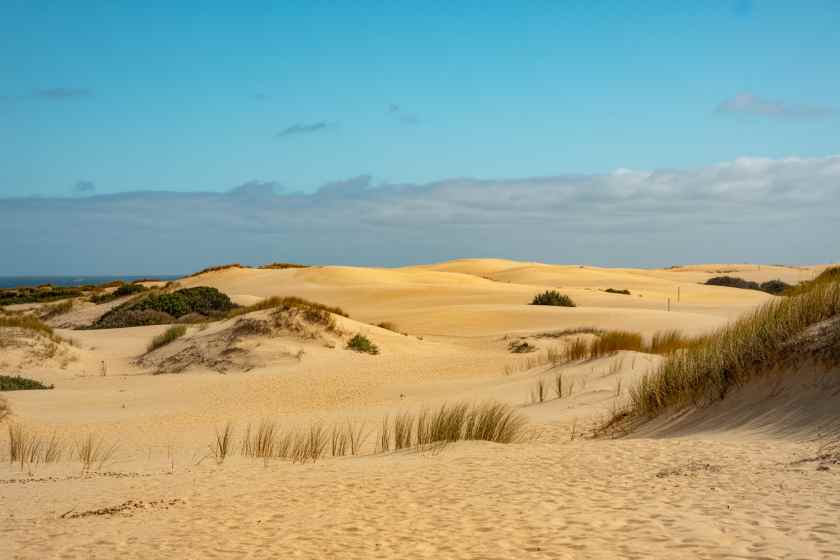Sustainable Tourism Needed: The Environmental Impact of Horseback Riding on Alentejo Dunes – Travel And Tour World

Report on the Environmental Impact of Tourism on Alentejo Coastal Dunes and Alignment with Sustainable Development Goals
1.0 Introduction and Executive Summary
This report examines the environmental impact of recreational activities, specifically horseback riding, on the fragile coastal dune ecosystems of the Alentejo region in Portugal. The analysis highlights the conflict between unregulated tourism and conservation efforts, framing the issue within the context of the United Nations Sustainable Development Goals (SDGs). An assessment by the non-governmental organization Brigada do Mar indicates that such activities jeopardize the ecological integrity of the dunes, which are vital for biodiversity and coastal protection. This situation presents a critical challenge to achieving sustainable tourism, directly impacting SDG 14 (Life Below Water), SDG 15 (Life on Land), and SDG 12 (Responsible Consumption and Production). The report outlines the ecological significance of the dunes, the threats they face, and recommends a strategic shift towards responsible tourism practices to ensure the long-term preservation of this natural heritage.
2.0 Ecological Significance and Threats to the Alentejo Dune System
The coastal dunes stretching between Tróia and Sines represent a critical ecosystem that supports a diverse range of flora and fauna. Their stability is essential for the health of the entire coastal region. However, the recent increase in unregulated tourism activities poses a significant threat.
2.1 Contribution to Biodiversity and Coastal Protection
- The dunes serve as a unique habitat for specialized plant species whose root systems bind the sand, preventing coastal erosion. This natural barrier is fundamental to protecting inland areas and aligns with the objectives of SDG 15 (Life on Land).
- These ecosystems are integral to the health of adjacent marine environments, acting as a buffer zone and contributing to the conservation of coastal and marine biodiversity, a key target of SDG 14 (Life Below Water).
2.2 Primary Threats from Unregulated Activities
- Horseback Riding: The physical pressure from horses damages fragile vegetation, disrupts the sand-binding root systems, and creates tracks that accelerate erosion. This directly undermines the natural regeneration process of the dunes.
- Habitat Degradation: The loss of vegetation leads to a cascading effect, impacting the fauna that depends on this habitat for survival and disrupting the ecological balance.
- Economic Unsustainability: While tourism provides economic benefits, reliance on environmentally destructive activities jeopardizes the long-term viability of the region’s eco-tourism sector, conflicting with the principles of SDG 8 (Decent Work and Economic Growth).
3.0 Conservation Initiatives and Multi-Stakeholder Collaboration
In response to these threats, several organizations are working to protect the Alentejo coast, demonstrating a commitment to partnership-based solutions as advocated by SDG 17 (Partnerships for the Goals).
3.1 The Role of Brigada do Mar
Brigada do Mar, a member of the International Union for the Conservation of Nature, has been instrumental in raising awareness and implementing direct action. Their efforts include:
- Organizing decontamination and waste removal operations along the coast.
- Advocating for the restriction of damaging activities like horseback riding in sensitive areas.
- Promoting the use of designated, non-destructive routes for visitors to experience the natural landscape.
3.2 Governmental and Policy Response
The Portuguese government has recognized the need to balance tourism with environmental protection. National strategies are increasingly focused on promoting sustainable tourism models for the Alentejo region that prioritize low-impact activities such as guided hiking, cycling, and wildlife observation. This policy direction supports SDG 12 (Responsible Consumption and Production) by encouraging tourism patterns that minimize environmental harm.
4.0 Recommendations for Advancing Sustainable Tourism in Alignment with SDGs
To secure the ecological and economic future of the Alentejo coast, a concerted effort is required from all stakeholders to adopt and promote responsible tourism practices.
4.1 For Tourism Operators and Local Authorities:
- Develop and enforce clear regulations that prohibit high-impact activities in ecologically sensitive dune areas.
- Promote responsible tourism packages that focus on environmental education and conservation, contributing to SDG 11 (Sustainable Cities and Communities) by safeguarding natural heritage.
- Collaborate with conservation organizations to create and maintain designated trails that minimize ecological disturbance.
4.2 For Tourists and Visitors:
- Adhere to sustainable tourism guidelines provided by official sources such as the Visit Portugal and APAMBIENTE websites.
- Choose low-impact activities and support local businesses committed to conservation efforts.
- Actively participate in preserving the natural environment by refraining from activities that harm the dune systems.
5.0 Conclusion: Safeguarding Alentejo’s Natural Heritage for Future Generations
The protection of the Alentejo coastal dunes is a matter of profound importance for preserving Portugal’s natural beauty and biodiversity. The current challenges posed by unregulated tourism underscore the urgent need for a paradigm shift towards sustainability. By integrating the principles of the Sustainable Development Goals into tourism management, policy-making, and individual behavior, it is possible to ensure that the Alentejo coast remains a pristine and valuable ecosystem for generations to come. This approach will not only protect the environment but also secure the long-term viability of the region’s tourism economy, creating a model of responsible and sustainable development.
Sustainable Development Goals (SDGs) Addressed in the Article
SDG 14: Life Below Water
- The article focuses on the Alentejo coastal dunes, which are critical coastal ecosystems. Protecting these systems is essential for marine environmental health, as they act as a natural barrier and support coastal biodiversity. The degradation of these dunes directly impacts the integrity of the coastal zone, which falls under the purview of SDG 14.
SDG 15: Life on Land
- This is the most directly relevant SDG. The article details the threat to a terrestrial ecosystem—the coastal dunes—and its “fragile and diverse flora and fauna.” It discusses the degradation of natural habitats caused by horseback riding, the destruction of vegetation, and the subsequent impact on the entire ecosystem, which are central themes of SDG 15.
SDG 8: Decent Work and Economic Growth
- The article links the conservation of the Alentejo coast to its tourism-based economy. It highlights the need for a “sustainable tourism model” that provides economic benefits (“unlock new avenues for tourism development”) while protecting the natural resources that attract tourists. This connects directly to promoting sustainable economic growth through responsible tourism.
SDG 12: Responsible Consumption and Production
- The article calls for a shift towards “responsible tourism practices” and “environmentally sustainable tourism.” It encourages tourists to choose low-impact activities and supports operators who offer “responsible packages.” This reflects the principles of sustainable consumption and production patterns within the tourism industry.
Specific SDG Targets Identified
Targets under SDG 14: Life Below Water
- Target 14.2: “Sustainably manage and protect marine and coastal ecosystems to avoid significant adverse impacts…” The entire article is a case study of the need to protect a coastal ecosystem (the dunes) from the adverse impacts of a specific human activity (horseback riding). The efforts of the NGDO “Brigada do Mar” to protect the dunes align directly with this target.
Targets under SDG 15: Life on Land
- Target 15.1: “Ensure the conservation, restoration and sustainable use of terrestrial… ecosystems…” The article’s central theme is the conservation of the Alentejo dune ecosystem and promoting its sustainable use through ecotourism, rather than destructive recreational activities.
- Target 15.5: “Take urgent and significant action to reduce the degradation of natural habitats, halt the loss of biodiversity…” The article explicitly states that horseback riding “directly destroys the delicate vegetation” and causes “the loss of crests and dunes,” which constitutes habitat degradation and threatens the region’s biodiversity.
Targets under SDG 8: Decent Work and Economic Growth
- Target 8.9: “By 2030, devise and implement policies to promote sustainable tourism that creates jobs and promotes local culture and products.” The article mentions that “Portugal’s National Strategy has attracted the attention of the government… concerning policy development that promotes tourism growth while protecting natural resources” and describes a “sustainable tourism model designed for the Alentejo region,” which directly corresponds to this target.
Indicators for Measuring Progress
Indicators for SDG 14 & 15 (Ecosystem Health)
- Condition of Dune Vegetation: The article implies this indicator by stating that horseback riding “directly destroys the delicate vegetation that the dune depends on for regeneration.” Progress could be measured by monitoring the recovery and coverage of native, sand-binding plant species in the affected areas.
- Dune System Integrity: The article mentions the “loss of crests and dunes” as a key impact. An implied indicator would be the measurement of dune morphology, stability, and the rate of natural regeneration, tracking whether the physical structures are recovering or continuing to degrade.
Indicators for SDG 8 & 12 (Sustainable Tourism)
- Prevalence of Sustainable Tourism Offerings: The article mentions that “local tour operators offer responsible packages.” An indicator of progress would be the number or percentage of tourism businesses in the Alentejo region that offer certified ecotours and other low-impact activities (hiking, cycling, wildlife watching) compared to high-impact ones.
- Implementation of Environmental Regulations: The article notes that “Sustainable tourism guides and regulations for the Alentejo can also be found on the Portuguese government sites.” An indicator would be the formal adoption, implementation, and enforcement of these regulations, including the establishment of designated routes that avoid sensitive areas as advocated by Brigada do Mar.
- Public and Tourist Awareness: The work of “Brigada Do Mar” to “enhance awareness on the need to curb land-destructive activities” implies that public awareness is a key factor. Progress could be measured through surveys assessing the understanding and behavior of tourists and locals regarding the fragility of the dune ecosystem and the importance of responsible practices.
Summary of SDGs, Targets, and Indicators
| SDGs | Targets | Indicators (Implied from the Article) |
|---|---|---|
| SDG 14: Life Below Water | 14.2: Sustainably manage and protect marine and coastal ecosystems. | Measurement of dune system integrity and stability to assess the health of the coastal zone. |
| SDG 15: Life on Land | 15.1: Ensure the conservation, restoration and sustainable use of terrestrial ecosystems. | Rate of natural regeneration of the dune ecosystem. |
| 15.5: Reduce the degradation of natural habitats and halt biodiversity loss. | Monitoring the coverage and health of native dune vegetation and local fauna. | |
| SDG 8: Decent Work and Economic Growth | 8.9: Devise and implement policies to promote sustainable tourism. | Number of local tour operators offering certified “responsible packages” and low-impact activities. |
| SDG 12: Responsible Consumption and Production | 12.b: Develop and implement tools to monitor sustainable development impacts for sustainable tourism. | Level of tourist and local awareness regarding sustainable practices; Existence and enforcement of government-issued sustainable tourism guides and regulations. |
Source: travelandtourworld.com
What is Your Reaction?
 Like
0
Like
0
 Dislike
0
Dislike
0
 Love
0
Love
0
 Funny
0
Funny
0
 Angry
0
Angry
0
 Sad
0
Sad
0
 Wow
0
Wow
0
















































:focal(1500,1000)/https://media.globalcitizen.org/a6/9a/a69a4720-d8a1-4715-b596-18738d03c05c/rotary_polio_hero_image.jpg?#)







/countries/sri-lanka/photo-credit---dmc-sri-lanka.tmb-1200v.jpg?sfvrsn=dc298bcc_1#)


















